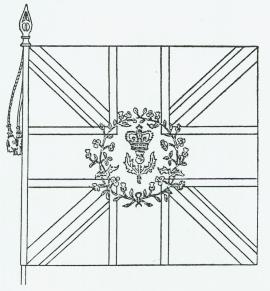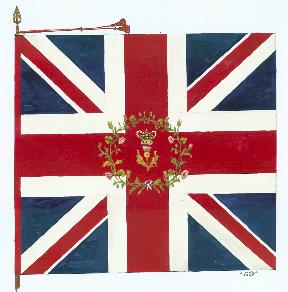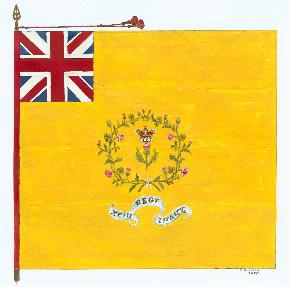|
British Colours (5) -- Patterns
1801-1815
 |
King's Colour, 1st Battalion, 93d
Foot, the Sutherland Highlanders, carried at Battle of New Orleans,
1815. This colour was presented in 1811 with yellow
regimental shown below. It would be expected that as the
center of the colour does not show the number or rank of the
regiment, it would be in the upper left canton near the
staff. There is no evidence, however, that colour was
altered, as was the regimental, on creation of a Second Battalion
of the 93d in 1813. Left:
Illustration from the old regimental history, with
oversized central design, misrepresentations of St George's cross,
white fimbriations, and crosses of St Andrew and St
Patrick, all typical of Milne's drawings. Note also that
the spear is not to scale--the flag is six feet on the staff, the
spear as pictured must be over twelve inches high instead of the
6-8 inches that it would be in life. Right: The
King's colour reconstructed as it would have looked in
life. The wreath, crown and thistle are all drawn from
the original, which still exists at the Regimental museum and
can be seen on the website of the Argyle and Sutherland
Highlanders. |
 |
Throughout the period 1790 to
1815 the heart, or "Chippendale" style shield was used on
the colours of most English and Welsh regiments. There were a
few variations, but all were neat, regular, and
symetrical--quite different from the earlier rococo style.
There were also several slight variations in the patterns of
wreath. Generally they featured only two roses on each
side and were almost perfectly symetrical. Painted wreaths
tended to be a bit more full or dense than the
embroidered. One pattern was especially light in
appearance and featured several smallish roses on each side.
Scottish regiments, particularly
the Highland regiments raised in the last years of the eighteenth
century, tended to be a bit more flamboyant. Several sported
the thistle as their central device, with or without garter and
motto, with or without crown. The wreaths were often made to
close completely at the top so as to be more of a circle than a
horse-shoe shape. But the general patterns set in
1743 and standardized by Col. Napier's drawings of 1747, continued
to be made until mid-ninteenth century. Throughout the period
encompassing the French and Indian Wars, the War for American
Independence, and the War of 1812, British colours displayed a
remarkable regularity and quality control that has, unfortunately,
been misunderstood and misrepresented almost ever since. |
 |
Regimental colour, 1st Battalion,
93d Foot, the Sutherland Highlanders, carried at the Battle of New
Orleans, 1815. This colour was originally presented in 1811;
it had the rank of the regiment, XCIII, in the center of the small
union, as the central shield common to most English regiments was
replaced with the crown and thistle. The original union was
apparently replaced and the scroll added in 1813, when a second
Battalion was created. Left:
Illustration from the old regimental history, with
oversized central design typical of Milne's drawings. The
small union is also drawn according to preconceived notion rather
than actual flag--the union still exists and can be seen on the
website of the Argyle and Sutherland Highlanders. Right: The
regimental colour reconstructed as it would have looked in
life. The central wreath is exactly like that on the King's
colour made and presented at the same time, the union is drawn
from the original at Regimental museum. |
 |
|